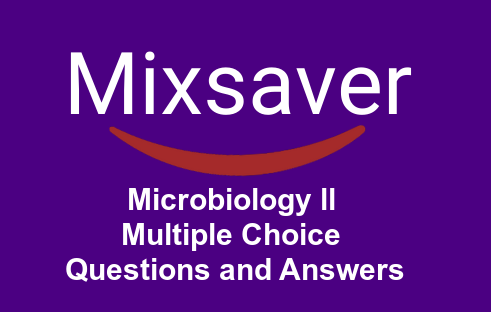Microbiology MCQ with answers pdf | Microbiology MCQs online test | Microbes in Healthcare & Medicine
1. Primary sludge is used for
(a) preparation of compost
(b) preparation of manure
(c) biogas production
(d) All of the above
Ans. d
2. Some blue-green algae are used as bio fertilisers because they
(a) are photosynthetic
(b) have mucilage
(c) grow everywhere
(d) fix nitrogen
Ans. d
3. The bacterium which is used in the prepartion of vitamin riboflavin is
(a) Leuconostoc
(b) Clostridium butylicum
(c) Lactobacillus
(d) None of these
Ans. b
4. Passage of effluents into oxidation tank is for
(a) primary treatment
(b) secondary treatment
(c) tertiary treatment
(d) Both (a) and (b)
Ans. b
5. Cyclosporin-A is used for
(a) dissolving blood clots
(b) lowering cholesterol level
(c) immunosuppression
(d) enhancing tenderness of meat
Ans. c
6. Lactic acid is used in
(a) preservation
(b) tanning
(c) plastic making
(d) All of these
Ans. d
7. Biological control component is controlled to advanced agricultural production, which of the following is used as a third generation pesticide?
(a) Insect hormone analogues
(b) Insect repellents
(c) Pheromones
(d) Pathogens
Ans. a
8. Acommon biocontrol agent for the control of plant disease is
(a) Baculovirus
(b) Bacillus thuringiensis
(c) Glomus
(d) Trichoderma
Ans. d
9. Which of the following is not used as biopesticide?
(a) Bacillus thuringiensis
(b) Tríchoderma harzianum
(c) Nuclear polyhedrosis virus
(d) Xanthomonas compestris
Ans. d
10. Sporeine is a bioinsecticide, based on Bacillus thuringiensis (Bt). It was developed in Germany and kills insects by inhabiting ion transport in
(a) foregut
(b) midgut
(c) hindgut
(d) digestive system
Ans. b
Microbiology NEET PG MCQ books pdf
11. A non-photosynthetic aerobic nitrogen fixing soil bacteria
(a) Rhizobium
(b) Clostridium
(c) Azotobacter
(d) Klebsiella
Ans. d
12. A fungus used for the biocontrol of plant pathogens is
(a) Trichoderma viridae
(b) Mucor mucedo
(c) Penicillium notatum
(d) Phytophthora parasitica
Ans. a
13. Lepidopterous are used as
(a) biofertilisers
(b) healthcare agents
(c) biological control
(d) None of these
Ans. c
14. Which of the following is used as biological controb
(a) Albugo
(b) Puccinia
(c) Phytophthora
(d) None of these
Ans. c
15. Azotobacter is used as
(a) biofertilisers
(b) biological control
(c) Both (a) and (b)
(d) None of these
Ans. a
16. Primary treatment of sewage is
(a) physical process
(b) biological process
(c) chemical process
(d) biochemical process
Ans. a
Bacteria multiple choice questions and answers pdf | Medical microbiology mcqs pdf free download
17. Farmyard manure and compost are prepared by bacterial action from
(a) refuse
(b) garbage
(c) animal excreta
(d) All of these
Ans. d
18. Which one is a biofertiliser?
(a) NPK mixture
(b) Rhizobia in legume roots
(c) Rhizobia in farmyard manure
(d) Green manure
Ans. b
19. Passage of effluents into oxidation tank is used for
(a) primary treatment
(b) secondary treatment
(c) Both (a) and (b)
(d) tertiary treatment
Ans. b
20. Which of the following can be controlled by using biopesticides?
(a) Insects
(b) Diseases
(c) Weeds
(d) All of these
Ans. d
21. Most common nitrogen-fixing cyanobacterium of padey fields is
(a) Cylindrospermum
(b) Aulosira
(c) Oscillatoria
(d) Nostoc
Ans. b
22. Cheese and yogurt are the products of
(a) S. greisas
(b) Lactobbacillus
(c) Streptococcus
(d) R. orzyae
Ans. c
General Microbiology Multiple Choice Questions | Microbiology MCQ Book PDF Download
23. ‘Palmivoralt’ is a
(a) herbicide
(b) fungicide
(c) nematocide
(d) rodenticide
Ans. a
24. Some blue-green algae are used as biofertiliser as they
(a) fix nitrogen
(b) are mucilaginous
(c) can grow everywhere
(d) are deficient in nutrient
Ans. a
25. Soil microorganisms are mainly comprised of
(a) fungi
(b) fungi and bacteria
(c) fungi, bacteria and Actinomycetes
(d) None of the above
Ans. c
26. Which one of the following groups of bacteria supplies nitrogen to our crop plants irrespective of crop rotation or manuring?
(a) Nitrosomonas
(b) Nitrobacter
(c) Rhizobium
(d) Azotobacter
Ans. b
27. An organism used as a biofertiliser for raising soybean crop production is
(a) Azospirillum
(b) Rhizobium
(c) Nostoc
(d) Azotobacter
Ans. d
28. Biofertilisers give better yield when added along with
(a) phosphate
(b) calcium
(c) nitrogen
(d) urea
Ans. a
29. BGA is chiefly used as biofertiliser in the crops of
(a) wheat
(b) gram
(c) paddy
(d) mustard
Ans. c
30. Symbiotic nitrogen fixing bacteria belongs to
(a) Xanthomonas
(b) Acetobacter
(c) Pseudomonas
(d) Rhizobium
Ans. d
Microbiology Multiple Choice Questions and Answers PDF
31. Which one of the following is used as biological insecticide?
(a) Silkmoth
(b) Caterpillar
(c) Mazra bok
(b) Tiger bettle
Ans. c
32. During anerobic digestion of organic waste, such as in producing biogas, which one of the following is left undergraded?
(a) Hemicellulose
(b) Lignin
(c) Lipids
(d) Cellulose
Ans.
33. Bacillus thuringiensis (Bt) strains have been used for designing novel
(a) biofertiliser
(b) bio-mineralisation processes
(c) bio-insecticidal plants
(d) bio-metallurgical techniques
Ans. c
34. Leghaemoglobin is a
(a) respiratory pigment in humans
(b) pigment present in leguminous plant
(c) Both (a) and (b)
(d) None of these
Ans. d
35. The common nitrogen-fixer in paddy fields in
(a) Frankia
(b) Rhizobium
(c) Azospirillum
(d) Oscillatoria
Ans. c
36. Which of the following is mainly produced by the activity of anaerobic bacteria on sewage?
(a) Marsh gas
(b) Laughing gas
(c) Propane
(d) Mustard gas
Ans. a
37. Agriculture by using only biofertilisers is called
(a) manuring
(b) composting
(c) inorganic farming
(d) organic farming
Ans. d
38. Cyanobacteria serves as important biofertilisers in the fields of
(a) rice
(b) maize
(c) wheat
(d) sugarcane
Ans. a
39. Physical removal of large and small from the sewage through filtration and sedimentation is called
(a) primary treatment
(b) secondary treatment
(c) tertiary treatment
(d) quaternary treatment
Ans. a
40. Secondary sewage treatment is mainly a
(a) biological process
(b) physical process
(c) mechanical process
(d) chemical process
Ans. a
41. The ergot of rye is caused by chemical
(a) ergotinine
(b) heparin
(c) histamine
(d) arginine
Ans. a
42. Nitrogen-fixation is performed by
(a) green alga and fungi
(b) mycorrhiza
(c) mycoplasma
(d) blue-green algae and bacteria
Ans. d
43. Nitrifying bacteria are
(a) chemosynthetic
(b) photoautotrophic
(c) parasitic
(d) saprotrophic
Ans. a
44. Nitrosomonas is a
(a) photoautotroph
(b) chemoautotroph
(c) chemoheterotroph
(d) photoheterotroph
Ans. b
45. Symbiotic nitrogen-fixing bacteria belong to
(a) Xanthomonas
(b) Acetobacter
(c) Pseudomonas
(d) Rhizobium
Ans. d
46. One of the following is a biofertiliser rich in free living nitrogen-fixing bacteria
(a) Rhizobium
(b) Micrococcus
(c) Pyrethrin
(d) Azotobacter
Ans.
47. Biogas is
(a) cheaper fuel
(b) ecofriendly fuel
(c) renewable source of energy
(d) All of the above
Ans. d
48. Gobar gas is produced by
(a) nitrifying bacteria
(b) methanogenic bacteria
(c) lactogenic bacteria
(d) oxidising bacteria
Ans. b
49. Thuricide is a proteinaceous toxin, which is obtained from
(a) biofertiliser
(b) bacterial origin
(c) green manure
(d) farmyard manure
Ans. b
50. Farmers have reported 50% higher yields of rice by using the biofertiliser
(a) mycorrhiza
(b) Azolla pinnata
(c) cyanobacteria
(d) legume-Rhizobium symbiosis
Ans. b





